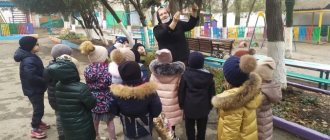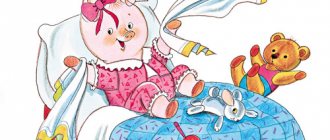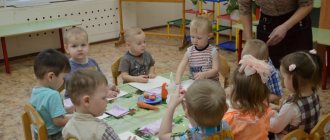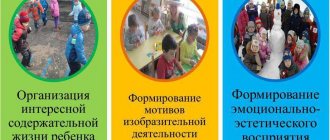“Methodology for organizing and conducting excursions and targeted walks in preschool educational institutions”
Transcript
1 “Methodology for organizing and conducting excursions and targeted walks in preschool educational institutions” Organization and methodology for conducting excursions Excursions, as a form of classes, are conducted in middle, senior and preparatory school groups at least once a month. According to the content, excursions are divided into 2 types: natural history (educational) excursions to the park, forest, lake, excursions to familiarize themselves with the work of adults. (school, library). It is advisable to conduct nature excursions to the same places at different times of the year in order to show children the seasonal changes that occur in nature. An excursion is much more difficult to conduct than a group lesson, so its success depends on careful preparation of the teacher and children. The teacher’s preparation consists primarily of determining the purpose of the excursion and selecting program content. The teacher plans an excursion based on the requirements of the program and the characteristics of the surrounding area. When determining the location of the excursion, the teacher chooses the best path to it that is not tiring and does not distract the children from the intended goal. When determining the distance to the excursion site, one should proceed from the physical capabilities of the children. The duration of the journey to the chosen place (one way) should not exceed 30 minutes in the middle group, minutes in the senior and preparatory groups. In this case, you should take into account the characteristics of the road and weather conditions. No matter how familiar the teacher is with the place of the excursion, it is necessary to inspect it a day or two before it. Having visited the site of the future excursion, the teacher clarifies the route, finds the necessary objects, outlines the content and scope of the knowledge that children should receive about a given range of phenomena, the sequence of individual parts of the excursion, establishes places for collective and independent observations, and for children to relax. In order for the excursion to be interesting, the teacher needs to prepare poems, riddles, proverbs, and game techniques. Preparing children begins with the teacher telling them the purpose of the excursion. The guys need to know where they will go, why, what they will learn, what they need to collect. The teacher reminds children about the rules of behavior on the street, in the forest, and in public places. When preparing for an excursion, you need to pay attention to the clothes of children. Children should be dressed comfortably, in accordance with the weather and season. In the system of preparatory work, training games are actively used, which involve the inclusion of elements of psycho-gymnastics in various types of children's activities and are aimed at developing adequate self-esteem and skills of constructive communication with the natural world, cultivating a value-based attitude towards what surrounds the child. For the excursion, the teacher should prepare excursion equipment and equipment for placing the collected material in a corner of nature. It is good to involve children in its preparation. This helps to arouse their interest in the upcoming excursion. All equipment must be located in a specific place. Before the excursion, the teacher needs to carefully consider what material to collect for further work in the group and what equipment to take with him in connection with this.
2 Methodology for conducting natural history educational excursions. A natural history excursion includes an introductory conversation, collective observation, individual independent observation of children, collection of natural history material, and children playing with the collected material. The order of the parts varies depending on the purpose of the excursion and the season. Having brought the children to the place of the excursion, you should remind them of its purpose in a short conversation and let the children look around. The main part of the excursion is collective observation, with the help of which all the main tasks of the excursion are solved. The teacher must help children notice and understand the characteristic signs of objects and phenomena. To do this, you can use various techniques: questions, riddles, comparisons, survey activities, games, stories, explanations. The level of cognitive activity is facilitated by elements of conversations and logical tasks offered by educators. An example is the question: “How is the birch tree in the park similar to the birch tree on your site? ", etc. It is advisable to use those that stimulate the expression of children's emotions and feelings. You can ask your students what kind words you can give to the flowers in the flower beds of the park, what wishes you can send to your feathered friends, etc. It is necessary to pay attention not only to individual natural objects, but also to ecological communities, considering the “floors” of the park and reservoir , defining the conditional interaction between them, building logical chains of connections and dependencies. Didactic games conducted during excursions should be focused on providing preschoolers with the opportunity to demonstrate an active, environmentally literate position in relation to natural objects. Topics can be the following: “Help a tree”, “Be careful, ant”, “Birds love silence”, “Good morning”, etc. Small environmental events expand the experience of environmental activities, support the desire to actively and independently help natural objects, allow you to experience the feeling pride in the work done. During excursions to a square, park, or pond, children, together with adults, can hang bird feeders, plant grown seedlings in flower beds and flower beds, plant trees, etc. The most significant thing is that during these activities, preschoolers accumulate emotionally positive experience of communicating with nature . During excursions, an important place is given to questions and tasks that force children to examine an object, compare it with other objects, find differences and similarities, and establish connections between various natural phenomena. When examining objects, it should be borne in mind that children’s knowledge will be strong only if it is obtained as a result of the active work of all senses. At the end of the main part, children are given the opportunity to satisfy their curiosity in individual independent observations and collection of natural history material. However, one should not forget about nature conservation; the collection of material should be strictly limited and carried out under the guidance or with the direct participation of a teacher. During children's rest, games and play exercises are held. Children consolidate knowledge about the characteristic features of an object, express in words an opinion about the quality of an object, remember the name of plants (“Guess by the smell”, “Find out by the description”, “Branch, branch, where is your baby?”, “One, two, three, k run to the birch!”) In the final part of the excursion, the teacher once again draws the children’s attention to the overall picture of nature. The main goal of the final stage is to summarize the excursion work. Creative tasks will allow the child to express his impressions and show his attitude towards the natural world. You can invite the children, together with the teacher, to compose books of fairy tales. For example, preschoolers can write a story about a park and imagine what tales an old spruce tree could tell them. Through the actions of the characters introduced into these literary works, one can express attitudes towards various environmental situations. As an option for creative tasks, the teacher suggests drawing up collective collages depicting surface and
3 underwater inhabitants of reservoirs, favorite park alleys, etc. Constructing ecosystem models from natural and waste materials will help children better understand the chain of relationships and interdependencies that exist in nature. After each excursion, the layout can be supplemented and transformed. Based on specific information, children build food chains, add new natural objects, etc. Thus, excursions help expand students’ understanding of ecological systems (parks, reservoirs), form ideas about their “life” throughout the year, and observe what changes occur with every natural object depending on the season, learn to love and protect the environment. Starting from the second junior group, targeted walks are carried out around the site with access beyond its boundaries. Taking into account the natural environment of the kindergarten, the most striking seasonal natural phenomena, the children’s capabilities, and the work done with them, the teacher decides where to go and what to see. Targeted walks, unlike excursions, are short-term, and a small volume of problems is solved during them. Children get acquainted with the striking natural phenomena of a particular season: bird nesting, ice drift. Targeted walks are carried out to a pond and a meadow. You can select one object for observation in the rural area, for example, a birch tree, and take targeted walks in different seasons, observing and noting the changes that have occurred. Tips for preparing and conducting walks along the route: - a walk-hike is carried out only after a thorough study of the route; — the content of the route or hike is carefully thought out; - an adult together with children prepares the necessary equipment and equipment; — thinking about children’s clothing that is comfortable and appropriate for the weather; — children and their parents are notified in advance about the time of the hike; — it is advisable to clarify the weather forecast; - the day before, a conversation is held with children about the rules of behavior while moving and in the process of communicating with objects of nature; — adults should have a good knowledge of berries, mushrooms, and plants growing in the area; must know the contents of the first aid kit and the rules for using it; - adults should be well aware of and take into account the individual and physical capabilities of children (movement should be in a certain rhythm, aligned with the weakest participant, walking should not be monotonous); — the plan and route are coordinated with the health worker, manager, deputy manager; — Adults must know and follow traffic rules well. Planning walks and hikes A long-term plan for carrying out walks and hikes can be drawn up approximately according to the following scheme: Date of implementation Topic or objects of observation Purpose Mark of completion A brief description of the route is given, halts and activities on them are noted. For each trip, a script is drawn up, indicating the location, departure time, form and duration. The content of the walk-trip consists of: - didactic games;
4 - outdoor games; - reading fiction; — experimental and practical work. Educators must find a successful combination of various types of physical activity with rest, taking into account the conditions of the area. Children can be taught navigation. Route maps are approved by the teachers' council, which is confirmed by the signature of the head on the map. All routes are numbered. Dangerous sections of the road and rest stops must be marked. The total length of the route and the length of the sections of the path between rest stops, as well as its duration, are noted. Before leaving, an entry is made in the notebook for the arrival and departure of the group on the hike according to the following scheme: group number of children date of the route number of accompanying persons, full name. time of departure, signature time of return, signature of who received the information Memo for educators on organizing excursions and targeted walks Pedestrian walks should be designed for a 30-minute walk in one direction. In such a hike, children’s strength strengthens, endurance develops, the ability to overcome difficulties, will and perseverance are exercised. The teacher outlines a route in advance on which a flat road alternates with various natural obstacles: slopes, logs, stumps, ditches, bridges, etc. resting places and places to set up camp. A music director and a nurse take part in such trips. A summary is being drawn up. It indicates: with which group the hike is being carried out and at what distance, place and time of departure, route. During walking walks, children must be organized in such a way that they can walk not only in pairs, but also freely, in groups of 3-4 people. There should be obstacles on the road: a fallen tree, low hanging branches, a stream, etc. The natural environment can always be used for jumping exercises: jump from flat stones, from stumps (no higher than 50 cm). For long jumps, use the width of paths and grooves. You can jump in height through a twig placed on two adjacent stumps, through low stumps. To climb over, use logs, fallen trees, and low-hanging branches for crawling. We must strive on every walk to exercise children in all types of basic movements, using a combination of natural conditions with special aids. For example: walk between two lines, throw the ball up and catch it with your hands, when you reach a stone, put the ball near it, stand on the stone, jump, walk on all fours to a hoop (woven from branches), crawl into it, run up to a branch with a hanging bell, jump up and ring. During a walking walk, organize with the children the collection of natural materials that can be used in design classes for work. After such a walk, children are asked to make sketches, and conversations are held about what they saw.
5 When setting up a camp, it is advisable to provide telephone communication, and limit the camp area with garlands of flags, flowers, etc. When organizing small tourism, provide measures to ensure the protection of the life and health of children. NOTE: Increase the duration of the route gradually, giving it the game form of a “tourist hike”. Make up your own little tourist song. Before going on a hike, give instructions on how to behave on a hike. At rest stops, organize recreation for children: songs, round dances, competitions, reading and looking at books, etc. Tourist equipment: Headdress (hat, cap, Panama), tracksuit, sneakers or sneakers. You need a backpack, dishes, toys, sports equipment (ball, skittles, jump ropes, etc.); Be sure to take a first aid kit and drinking water with you. You can take musical instruments with you
Features of a targeted walk with children
Increasing attention to the environmental education of preschool children requires a search for various forms of familiarization with nature. One of these forms, the potential of which is not yet sufficiently used by educators, is targeted walks into nature, combined with pedestrian crossings, which make it possible to introduce children to the immediate natural environment.
Targeted walks add variety to children's lives, enrich their imagination, allow them to better know the surrounding nature, the area where they live: park, square, forest, meadows, field, pond, river. Such walks can be carried out not only for educational purposes, but also for educational and practical purposes - collecting seeds of wild herbs for feeding birds in winter, plants for compiling a herbarium, natural material for manual labor.
The volume of program tasks planned for implementation on the target walk is significantly less than what is expected by the tour. And yet, the value of such walks is that, thanks to their regularity, it is possible to trace changes in natural objects and discover their causes.
Summer provides especially many opportunities for observations during targeted walks. Plants are blooming, the variety of species of insects, birds, and their adaptive behavior create unlimited scope for providing children with interesting information aimed at understanding their native nature and its beauty.
Sometimes you can hear the question: why do young children need knowledge about the plant and animal world? It is enough that they acquire knowledge about the most important relationships in nature between the organism and the conditions of existence. But the acquisition of knowledge can never be considered in preschool age as an end in itself. This is an aspect of the comprehensive development of the child.
What is the role of targeted walks in the formation of children’s environmental culture?
Targeted walks are valuable because during them children gain knowledge about the relationships in nature, the value for humans of certain natural objects, and the rules of environmental management. On targeted walks, children can practice following the rules of environmental management: in the forest, in the meadow, we are guests, and we need to behave politely, not to disturb the peace of those who permanently live there.
Familiarization with various natural objects during targeted walks is an important means of children’s aesthetic development. The perception of colorful landscapes, harmonious combinations of colors in flowers - all this awakens in children a sense of beauty and fosters a love for nature. A big role in this is played by the emotional sensitivity of the teacher, the ability not only to see the beauty of nature, but also to convey this clearly to children in order to instill aesthetic values that are important not only for the aesthetic development of the individual, but also for a good, humane attitude towards the surrounding nature.
Purposeful walks in nature are a source of enriching life with beauty. By teaching children after walks to depict nature on paper - flowers, butterflies, etc., educators form their aesthetic tastes and desire to create beauty around them. Nature is the environment in which children live, the beauty of which they perceive, it pleases the eye, having a strong influence on the formation of their personality.
The difference between a targeted walk and an excursion:
The concept of a WALK implies simply a walk in the fresh air, as well as shopping, or other places, without a clearly defined goal, so to speak, a promenade, and an EXCURSION implies a certain educational function - getting to know the sights, memorable places, architectural and other outstanding natural or man-made masterpieces.
62. A variety of leisure activities with natural history content.
The essence of the concept of “leisure activity”.
What synonyms for the concept of “leisure” do you know?
"rest",
"cultural and leisure activities"
"free time".
However, it is important to emphasize that not only at the everyday level, but also in educational literature and even in individual scientific works, there is an incorrect understanding and interpretation of these concepts. An elementary analysis of concepts determines the need to take into account that these are not only different concepts, but also terms related to different areas of scientific knowledge.
Free time is a socio-economic category, rest is a psychophysiological category, cultural and leisure activities are a philosophical and cultural category, leisure is a socio-pedagogical category.
Free time is a large part of the total budget of time spent in a preschool educational institution, remaining with the child after satisfying physiological, sanitary, hygienic and other essential needs, which he can use in accordance with his interests and capabilities under the guidance of a teacher. In their free time, children engage in interesting and meaningful activities, in their opinion, that evoke a feeling of joy and self-confidence, expand their circle of communication with adults and peers, filling it with meaningful content, and ultimately forming the foundations of a common culture; Therefore, it is necessary to teach the child to use his free time correctly and provide him with the opportunity to engage in a variety of activities of his choice.
Rest is a psychophysiological process occurring in a child’s body, reflecting the release of physical, mental, and intellectual stress, restoration and further development of strength. Rest can be long and short-term, effective and unsuccessful, complete and incomplete, but this is the subject of medicine, psychology and hygiene.
Cultural-domestic activity is a collective way of life of people distinguished by a number of common characteristics, carried out in an individual form, possessing isolation and relative independence. Cultural and leisure activities are aimed at satisfying personal needs and interests in the field of leisure; for the comprehensive development of the child’s personality
Leisure is a form of activity in free time that provides rest, organically combined with the diversified development of the individual. Leisure, like any activity, includes the following components: motive (need for activity), task, actions (operations). The sphere of leisure requires special attention from preschool educational institutions and should be not just an area of children’s free time, but in a certain sense an area of cultural pastime, containing environmental and educational potential, transforming environmental ideas, attitudes towards nature, skills and habits of behavior of preschoolers in nature .





